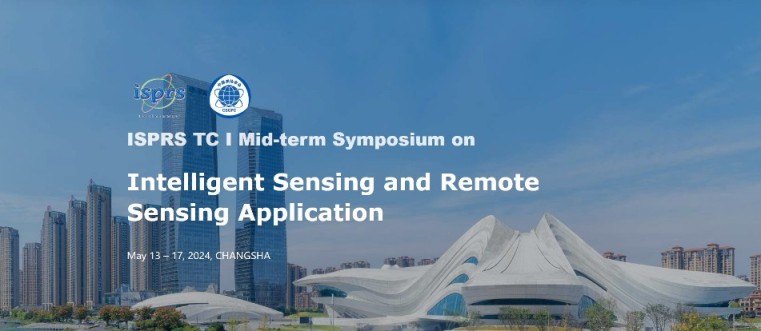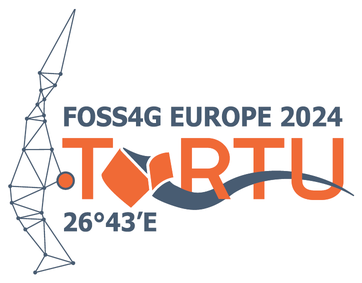Journal Description
ISPRS International Journal of Geo-Information
ISPRS International Journal of Geo-Information
is an international, peer-reviewed, open access journal on geo-information. The journal is owned by the International Society for Photogrammetry and Remote Sensing (ISPRS) and is published monthly online by MDPI.
- Open Access— free for readers, with article processing charges (APC) paid by authors or their institutions.
- High Visibility: indexed within Scopus, SCIE (Web of Science), GeoRef, PubAg, dblp, Astrophysics Data System, Inspec, and other databases.
- Journal Rank: JCR - Q2 (Geography, Physical) / CiteScore - Q1 (Geography, Planning and Development)
- Rapid Publication: manuscripts are peer-reviewed and a first decision is provided to authors approximately 35.5 days after submission; acceptance to publication is undertaken in 2.7 days (median values for papers published in this journal in the second half of 2023).
- Recognition of Reviewers: reviewers who provide timely, thorough peer-review reports receive vouchers entitling them to a discount on the APC of their next publication in any MDPI journal, in appreciation of the work done.
Impact Factor:
3.4 (2022);
5-Year Impact Factor:
3.5 (2022)
Latest Articles
Integrating Spatial and Non-Spatial Dimensions to Evaluate Access to Rural Primary Healthcare Service: A Case Study of Songzi, China
ISPRS Int. J. Geo-Inf. 2024, 13(5), 142; https://doi.org/10.3390/ijgi13050142 (registering DOI) - 27 Apr 2024
Abstract
Access to rural primary healthcare services has been broadly studied in the past few decades. However, most earlier studies that focused on examining access to rural healthcare services have conventionally treated spatial and non-spatial access as separate factors. This research aims to measure
[...] Read more.
Access to rural primary healthcare services has been broadly studied in the past few decades. However, most earlier studies that focused on examining access to rural healthcare services have conventionally treated spatial and non-spatial access as separate factors. This research aims to measure access to primary healthcare services in rural areas with the consideration of both spatial and non-spatial dimensions. The methodology of study is threefold. First, the Gaussian two-step floating catchment area (G-2SFCA) method was adopted to measure spatial access to primary healthcare services. Then, a questionnaire survey was conducted to investigate non-spatial access factors, including demographic condition, patient’s household income, healthcare insurance, education level, and patient satisfaction level with the services. After that, a comprehensive evaluation index system was employed to integrate both spatial and non-spatial access. The empirical study showed a remarkable disparity in spatial access to primary healthcare services. In total, 78 villages with 185,137 local people had a “low” or “very low” level of spatial access to both clinics and hospitals. For the non-spatial dimension, the results depicted that Songzi had significant inequalities in socioeconomic status (e.g., income, education) and patient satisfaction level for medical service. When integrating both spatial and non-spatial factors, the disadvantaged areas were mainly located in the eastern and middle parts. In addition, this study found that comprehensively considering the spatial and non-spatial access had a significant impact on results in healthcare access. In conclusion, this study calls for policymakers to pay more attention to primary healthcare inequalities within rural areas. The spatial and non-spatial access should be considered comprehensively when the long-term rural medical support policy is designated.
Full article
Open AccessArticle
A Sensor-Based Simulation Method for Spatiotemporal Event Detection
by
Yuqin Jiang, Andrey A. Popov, Zhenlong Li, Michael E. Hodgson and Binghu Huang
ISPRS Int. J. Geo-Inf. 2024, 13(5), 141; https://doi.org/10.3390/ijgi13050141 - 23 Apr 2024
Abstract
►▼
Show Figures
Human movements in urban areas are essential to understand human–environment interactions. However, activities and associated movements are full of uncertainties due to the complexity of a city. In this paper, we propose a novel sensor-based approach for spatiotemporal event detection based on the
[...] Read more.
Human movements in urban areas are essential to understand human–environment interactions. However, activities and associated movements are full of uncertainties due to the complexity of a city. In this paper, we propose a novel sensor-based approach for spatiotemporal event detection based on the Discrete Empirical Interpolation Method. Specifically, we first identify the key locations, defined as “sensors”, which have the strongest correlation with the whole dataset. We then simulate a regular uneventful scenario with the observation data points from those key locations. By comparing the simulated and observation scenarios, events are extracted both spatially and temporally. We apply this method in New York City with taxi trip record data. Results show that this method is effective in detecting when and where events occur.
Full article
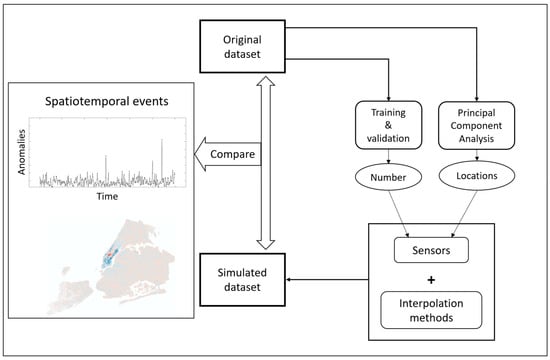
Figure 1
Open AccessArticle
AED Inequity among Social Groups in Guangzhou
by
Feng Gao, Siyi Lu, Shunyi Liao, Wangyang Chen, Xin Chen, Jiemin Wu, Yunjing Wu, Guanyao Li and Xu Han
ISPRS Int. J. Geo-Inf. 2024, 13(4), 140; https://doi.org/10.3390/ijgi13040140 - 22 Apr 2024
Abstract
Automated external defibrillators (AEDs) are regarded as the most important public facility after fire extinguishers due to their importance to out-of-hospital cardiac arrest (OHCA) victims. Previous studies focused on the location optimization of the AED, with little attention to inequity among different social
[...] Read more.
Automated external defibrillators (AEDs) are regarded as the most important public facility after fire extinguishers due to their importance to out-of-hospital cardiac arrest (OHCA) victims. Previous studies focused on the location optimization of the AED, with little attention to inequity among different social groups. To comprehensively investigate the spatial heterogeneity of the AED inequity, we first collected AED data from a WeChat applet. Then, we used the geographically weighted regression (GWR) model to quantify the inequity level and identify the socio-economic status group that faced the worst inequity in each neighborhood. Results showed that immigrants of all ages suffer a more severe AED inequity than residents after controlling population and road density. Immigrants face more severe inequity in downtown, while residents face more severe inequity in the peripheral and outer suburbs. AED inequity among youngsters tends to be concentrated in the center of each district, while inequity among the elderly tends to be distributed at the edge of each district. This study provides a new perspective for investigating the inequity in public facilities, puts forward scientific suggestions for future AED allocation planning, and emphasizes the importance of the equitable access to AED.
Full article
(This article belongs to the Special Issue HealthScape: Intersections of Health, Environment, and GIS&T)
►▼
Show Figures
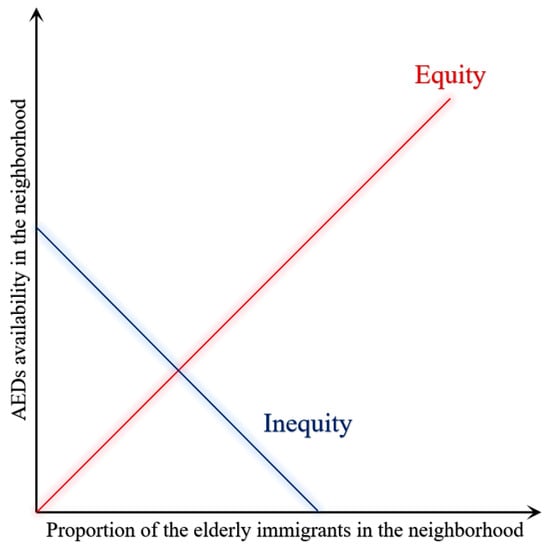
Figure 1
Open AccessArticle
Research on the Spatial Network Structure of Tourist Flows in Hangzhou Based on BERT-BiLSTM-CRF
by
Danfeng Qi, Bingbing Wang, Qiuhao Zhao and Pingbin Jin
ISPRS Int. J. Geo-Inf. 2024, 13(4), 139; https://doi.org/10.3390/ijgi13040139 - 21 Apr 2024
Abstract
►▼
Show Figures
Tourist flows, crucial information within online travelogues, reveal the interactive relationships between different tourist destinations and serve as the nerve center and link of the tourism system. This study takes Hangzhou, China, as a case to investigate the spatial network structure of its
[...] Read more.
Tourist flows, crucial information within online travelogues, reveal the interactive relationships between different tourist destinations and serve as the nerve center and link of the tourism system. This study takes Hangzhou, China, as a case to investigate the spatial network structure of its tourist flows. Firstly, a BERT-BiLSTM-CRF model and pan-attraction database are built to extract tourist attractions from online travelogues and create the tourist flow matrix. Then, this study uses social network analysis (SNA) to examine the structure of the tourist flow network from a county-level perspective. Additionally, GIS spatial analysis methods are applied to analyze the evolution of the tourist gravity center and standard deviation ellipse (SDE) of the network. The results reveal that the identification performances of the tourist flow extraction model this study proposed are significantly better than those of previous mainstream models, with an F1 value of 0.8752. Furthermore, the tourist flow network in Hangzhou displays a relatively sparse and unbalanced distribution, forming a “Core–Semi-Periphery–Periphery” structure. Lastly, from 2020 to 2022, the network’s gravity center experienced a shift towards the southwest, paralleled by an initial expansion and subsequent contraction of the SDE in the same southwest direction. These findings provide valuable insights into the spatial network structure of tourism in Hangzhou and can serve as a reference for policymakers to promote the “all-for-one” tourism.
Full article
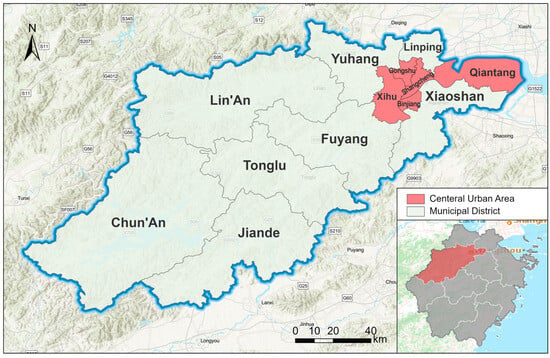
Figure 1
Open AccessArticle
A Novel Address-Matching Framework Based on Region Proposal
by
Yizhuo Quan, Yuanfei Chang, Linlin Liang, Yanyou Qiao and Chengbo Wang
ISPRS Int. J. Geo-Inf. 2024, 13(4), 138; https://doi.org/10.3390/ijgi13040138 - 21 Apr 2024
Abstract
►▼
Show Figures
Geocoding is a fundamental component of geographic information science that plays a crucial role in various geographical studies and applications involving text data. Current mainstream geocoding methods fall into two categories: geodesic-grid prediction and address matching. However, the geodesic-grid-prediction method’s localization accuracy is
[...] Read more.
Geocoding is a fundamental component of geographic information science that plays a crucial role in various geographical studies and applications involving text data. Current mainstream geocoding methods fall into two categories: geodesic-grid prediction and address matching. However, the geodesic-grid-prediction method’s localization accuracy is hindered by the density of grid partitioning, struggling to strike a balance between prediction accuracy and grid density. Address-matching methods mainly focus on the semantics of query text. However, they tend to ignore keyword information that can be used to distinguish candidates and introduce potential interference, which reduces matching accuracy. Inspired by the human map-usage process, we propose a two-stage address-matching approach that integrates geodesic-grid prediction and text-matching models. Initially, a multi-level text-classification model is used to generate a retrieval region proposal for an input query text. Subsequently, we search for the most relevant point of interest (POI) within the region-proposal area using a semantics-based text-retrieval model. We evaluated the proposed method using POI data from the Beijing Chaoyang District. The experimental results indicate that the proposed method provides high address-matching accuracy, increasing Recall@1 by 0.55 to 1.56 percentage points and MRR@5 by 0.54 to 1.68 percentage points.
Full article
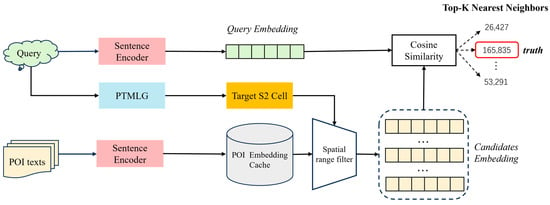
Figure 1
Open AccessArticle
Comprehension of City Map Pictograms Designed for Specific Tourists’ Needs
by
Dorotea Kovačević, Maja Brozović and Klementina Možina
ISPRS Int. J. Geo-Inf. 2024, 13(4), 137; https://doi.org/10.3390/ijgi13040137 - 18 Apr 2024
Abstract
►▼
Show Figures
This study investigated the effectiveness of new point-of-interest (POI) pictograms on tourist maps within the Croatian and Slovenian contexts, focusing on enhancing the tourist experience in urban settings for individuals with specific needs. Despite the widespread use of tourist maps, there is a
[...] Read more.
This study investigated the effectiveness of new point-of-interest (POI) pictograms on tourist maps within the Croatian and Slovenian contexts, focusing on enhancing the tourist experience in urban settings for individuals with specific needs. Despite the widespread use of tourist maps, there is a lack of research evaluating POI pictograms tailored to the needs of tourists with specific dietary, health-related, and sustainable clothing purchases. To fill this gap, we designed six new pictograms in three domains: healthcare, food, and apparel. The pictograms were evaluated using an online questionnaire involving 138 participants with a diverse range of ages and educational backgrounds. The results on comprehension and subjective assessments of the pictograms’ qualities revealed insights into the subtle cultural and lifestyle influences on pictogram perception. The findings provide a basis for considering the potential of new pictogram designs in improving navigational experiences with geospatial information and encouraging sustainable tourist behaviors.
Full article
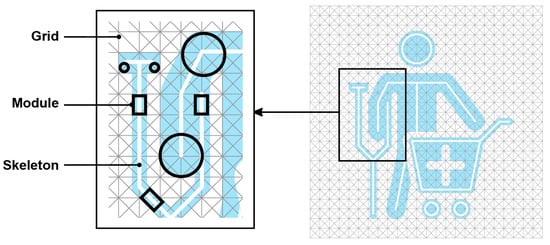
Figure 1
Open AccessArticle
Scale Distribution of Retail Formats in the Central Districts of Chinese Cities: A Study Analysis of Ten Cities
by
Yi Shi, Yidian Wang, Yifan Ren, Chunyu Zhou and Xinyu Hu
ISPRS Int. J. Geo-Inf. 2024, 13(4), 136; https://doi.org/10.3390/ijgi13040136 - 18 Apr 2024
Abstract
►▼
Show Figures
Analyses of urban hierarchy and scale distribution are crucial in urban research, as they examine the laws of urban development and the functional layout of urban spatial systems. However, previous studies have focused on the macro-spatial distribution of the economy, businesses, and population
[...] Read more.
Analyses of urban hierarchy and scale distribution are crucial in urban research, as they examine the laws of urban development and the functional layout of urban spatial systems. However, previous studies have focused on the macro-spatial distribution of the economy, businesses, and population at the regional level, whereas systematic research on the scale distribution of retail formats in central urban areas is lacking. Therefore, this study investigated the hierarchical scale distribution of retail formats in the top ten cities in China by GDP, using the Public Service Facilities Index Method to define central district boundaries, using scale as an epistemological framework of order and analyzing the spatial distribution patterns of retail formats. The results revealed that the spatial hierarchical scale follows a power law within a certain range; the spatial distribution exhibits stage characteristics, providing a quantitative method for defining retail centres; and the dominant functions, development directions, and morphological characteristics of central districts influence the hierarchical scale distribution of retail formats.
Full article
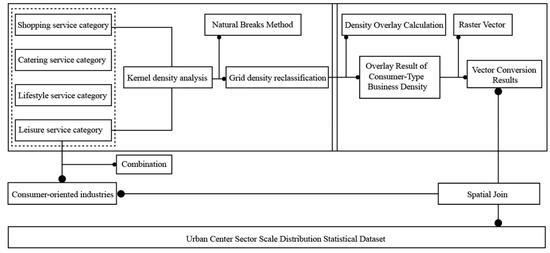
Figure 1
Open AccessArticle
A Hierarchy-Aware Geocoding Model Based on Cross-Attention within the Seq2Seq Framework
by
Linlin Liang, Yuanfei Chang, Yizhuo Quan and Chengbo Wang
ISPRS Int. J. Geo-Inf. 2024, 13(4), 135; https://doi.org/10.3390/ijgi13040135 - 17 Apr 2024
Abstract
►▼
Show Figures
Geocoding converts unstructured geographic text into structured spatial data, which is crucial in fields such as urban planning, social media spatial analysis, and emergency response systems. Existing approaches predominantly model geocoding as a geographic grid classification task but struggle with the output space
[...] Read more.
Geocoding converts unstructured geographic text into structured spatial data, which is crucial in fields such as urban planning, social media spatial analysis, and emergency response systems. Existing approaches predominantly model geocoding as a geographic grid classification task but struggle with the output space dimensionality explosion as the grid granularity increases. Furthermore, these methods generally overlook the inherent hierarchical structure of geographical texts and grids. In this paper, we propose a hierarchy-aware geocoding model based on cross-attention within the Seq2Seq framework, incorporating S2 geometry to model geocoding as a task for generating grid labels and predicting S2 tokens (labels of S2 grids) character-by-character. By incorporating a cross-attention mechanism into the decoder, the model dynamically perceives the address contexts at the hierarchical level that are most relevant to the current character prediction based on the input address text. Results show that the proposed model significantly outperforms previous approaches across multiple metrics, with a median and mean distance error of 41.46 m and 93.98 m, respectively. Furthermore, our method achieves superior results compared to others in regions with sparse data distribution, reducing the median and mean distance error by 16.27 m and 7.52 m, respectively, suggesting that our model has effectively mitigated the issue of insufficient learning in such regions.
Full article

Figure 1
Open AccessArticle
Spatiotemporal Analysis of Water Body in the Chongming Island Region over the Past Decade Based on the ISUNet Model
by
Lizhi Miao, Xinkai Feng, Lijun Yang, Yanhui Ren, Yamei Deng and Tian Hang
ISPRS Int. J. Geo-Inf. 2024, 13(4), 134; https://doi.org/10.3390/ijgi13040134 - 17 Apr 2024
Abstract
►▼
Show Figures
Chongming Island and its surrounding areas are highly significant coastal regions in China. However, the regions undergo continuous changes owing to various factors, such as the sedimentation from the Yangtze River, human activities, and tidal movements. Chongming Island is part of the Yangtze
[...] Read more.
Chongming Island and its surrounding areas are highly significant coastal regions in China. However, the regions undergo continuous changes owing to various factors, such as the sedimentation from the Yangtze River, human activities, and tidal movements. Chongming Island is part of the Yangtze River Delta, which is one of the most economically developed regions in China. Studying the water body changes in this area is of great importance for decision making in water resource conservation, coastal resource management, and ecological environmental protection. In this study, we propose an improved ISUNet model by enhancing the skip-connection operations in the traditional UNet architecture. We extracted and analyzed the water bodies in Chongming Island and its surrounding areas from 2013 to 2022, providing a detailed spatiotemporal analysis of the water body area over the years. The results indicate that the water body area in the study area has decreased by 267.8 km2 over the past decade, showing a gradually fluctuating downward trend with an average annual reduction of nearly 27 km2. The analysis suggests that the reduction in the water body area is mainly attributed to sedimentation near river channels and ports, the formation of sandbars owing to channel erosion, and the artificial construction of ports and coastal areas. The influencing factors include human activities and sedimentation from the Yangtze River Estuary. Specifically, human activities such as land reclamation, port construction, and aquaculture play a major role in causing changes in the area.
Full article
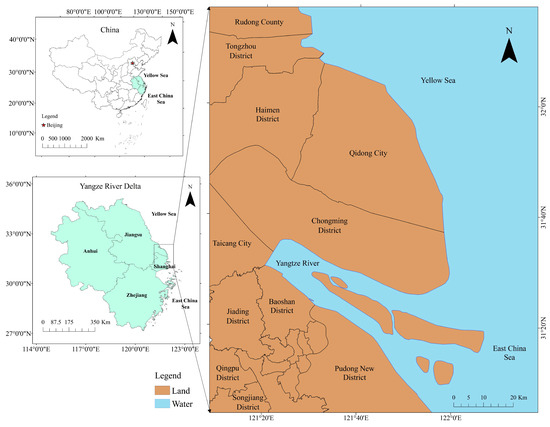
Figure 1
Open AccessArticle
An LLM-Based Inventory Construction Framework of Urban Ground Collapse Events with Spatiotemporal Locations
by
Yanan Hao, Jin Qi, Xiaowen Ma, Sensen Wu, Renyi Liu and Xiaoyi Zhang
ISPRS Int. J. Geo-Inf. 2024, 13(4), 133; https://doi.org/10.3390/ijgi13040133 - 16 Apr 2024
Abstract
Historical news media reports serve as a vital data source for understanding the risk of urban ground collapse (UGC) events. At present, the application of large language models (LLMs) offers unprecedented opportunities to effectively extract UGC events and their spatiotemporal information from a
[...] Read more.
Historical news media reports serve as a vital data source for understanding the risk of urban ground collapse (UGC) events. At present, the application of large language models (LLMs) offers unprecedented opportunities to effectively extract UGC events and their spatiotemporal information from a vast amount of news reports and media data. Therefore, this study proposes an LLM-based inventory construction framework consisting of three steps: news reports crawling, UGC event recognition, and event attribute extraction. Focusing on Zhejiang province, China, as the test region, a total of 27 cases of collapse events from 637 news reports were collected for 11 prefecture-level cities. The method achieved a recall rate of over 60% and a precision below 35%, indicating its potential for effectively and automatically screening collapse events; however, the accuracy needs to be improved to account for confusion with other urban collapse events, such as bridge collapses. The obtained UGC event inventory is the first open access inventory based on internet news reports, event dates and locations, and collapse co-ordinates derived from unstructured contents. Furthermore, this study provides insights into the spatial pattern of UGC frequency in Zhejiang province, effectively supplementing the statistical data provided by the local government.
Full article
(This article belongs to the Special Issue Innovative GIS Models and Approaches for Large Environmental and Urban Applications in the Age of AI)
►▼
Show Figures

Figure 1
Open AccessArticle
Evaluating the Impact of Human Activities on Vegetation Restoration in Mining Areas Based on the GTWR
by
Li Guo, Jun Li, Chengye Zhang, Yaling Xu, Jianghe Xing and Jingyu Hu
ISPRS Int. J. Geo-Inf. 2024, 13(4), 132; https://doi.org/10.3390/ijgi13040132 - 16 Apr 2024
Abstract
The clarification of the impact of human activities on vegetation in mining areas contributes to the harmonization of mining and environmental protection. This study utilized Geographically and Temporally Weighted Regression (GTWR) to establish a quantitative relationship among the Normalized Difference Vegetation Index (
[...] Read more.
The clarification of the impact of human activities on vegetation in mining areas contributes to the harmonization of mining and environmental protection. This study utilized Geographically and Temporally Weighted Regression (GTWR) to establish a quantitative relationship among the Normalized Difference Vegetation Index (NDVI), temperature, precipitation, and Digital Elevation Model (DEM). Furthermore, residual analysis was performed to remove the impact of natural factors and separately assess the impact of human activities on vegetation restoration. The experiment was carried out in Shangwan Mine, China, and following results were obtained: (1) During the period of 2000 to 2020, intensified huan activities corresponded to positive vegetation changes (NDVI-HA) that exhibited an upward trend over time. (2) The spatial heterogeneity of vegetation restoration was attributed to the DEM. It is negatively correlated with NDVI in natural conditions, while under the environment of mining activities, there is a positive correlation between NDVI-HA and DEM. (3) The contribution of human activities to vegetation restoration in mining areas has been steadily increasing, surpassing the influences of temperature and precipitation since 2010. The results of this study can provide important references for the assessment of vegetation restoration to some extent in mining areas.
Full article
(This article belongs to the Topic Advances in Earth Observation and Geosciences)
►▼
Show Figures
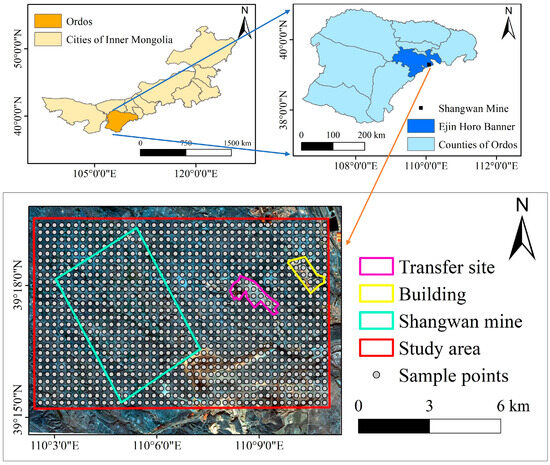
Figure 1
Open AccessArticle
Unveiling the Non-Linear Influence of Eye-Level Streetscape Factors on Walking Preference: Evidence from Tokyo
by
Lu Huang, Takuya Oki, Sachio Muto and Yoshiki Ogawa
ISPRS Int. J. Geo-Inf. 2024, 13(4), 131; https://doi.org/10.3390/ijgi13040131 - 15 Apr 2024
Abstract
Promoting walking is crucial for sustainable development and fosters individual health and well-being. Therefore, comprehensive investigations of factors that make walking attractive are vital. Previous research has linked streetscapes at eye-level to walking preferences, which usually focuses on simple linear relationships, neglecting the
[...] Read more.
Promoting walking is crucial for sustainable development and fosters individual health and well-being. Therefore, comprehensive investigations of factors that make walking attractive are vital. Previous research has linked streetscapes at eye-level to walking preferences, which usually focuses on simple linear relationships, neglecting the complex non-linear dynamics. Additionally, the varied effects of streetscape factors across street segments and intersections and different street structures remain largely unexplored. To address these gaps, this study explores how eye-level streetscapes influence walking preferences in various street segments and intersections in Setagaya Ward, Tokyo. Using street view data, an image survey, and computer vision algorithms, we measured eye-level streetscape factors and walking preferences. The Extreme Gradient Boosting (XGBoost) model was then applied to analyze their non-linear relationships. This study identified key streetscape factors influencing walking preferences and uncovered non-linear trends within various factors, showcasing a variety of patterns, including upward, downward, and threshold effects. Moreover, our findings highlight the heterogeneity of the structural characteristics of street segments and intersections, which also impact the relationship between eye-level streetscapes and walking preferences. These insights can significantly inform decision-making in urban streetscape design, enhancing pedestrian perceptions.
Full article
(This article belongs to the Special Issue Application of Geographical Information System in Urban Design, Management or Evaluation)
►▼
Show Figures
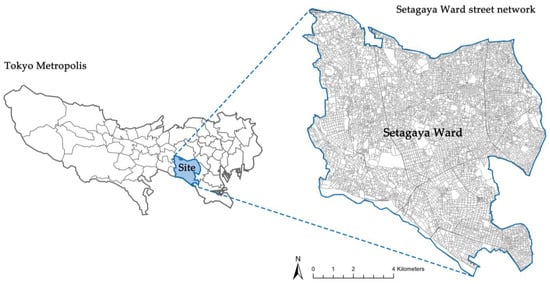
Figure 1
Open AccessArticle
Multi-Criteria Framework for Routing on Access Land: A Case Study on Dartmoor National Park
by
Rafael Felipe Sprent, James Haworth, Stefano Cavazzi and Ilya Ilyankou
ISPRS Int. J. Geo-Inf. 2024, 13(4), 130; https://doi.org/10.3390/ijgi13040130 - 14 Apr 2024
Abstract
►▼
Show Figures
Creating routes across open areas is challenging due to the absence of a defined routing network and the complexity of the environment, in which multiple criteria may affect route choice. In the context of urban environments, research has found Visibility and Spider-Grid subgraphs
[...] Read more.
Creating routes across open areas is challenging due to the absence of a defined routing network and the complexity of the environment, in which multiple criteria may affect route choice. In the context of urban environments, research has found Visibility and Spider-Grid subgraphs to be effective approaches that generate realistic routes. However, the case studies presented typically focus on plazas or parks with defined entry and exit points; little work has been carried out to date on creating routes across open areas in rural settings, which are complex environments with varying terrain and obstacles and undefined entry or exit points. To address this gap, this study proposes a method for routing across open areas based on a Spider-Grid subgraph using queen contiguity. The method leverages a Weighted Sum–Dijkstra’s algorithm to allow multiple criteria such as surface condition, total time, and gradient to be considered when creating routes. The method is tested on the problem of routing across two areas of Dartmoor National Park, United Kingdom. The generated routes are compared with benchmark algorithms and real paths created by users of the Ordnance Survey’s Maps App. The generated routes are found to be more realistic than those of the benchmark methods and closer to the real paths. Furthermore, the routes are able to bypass hazards and obstacles while still providing realistic and flexible routes to the user.
Full article
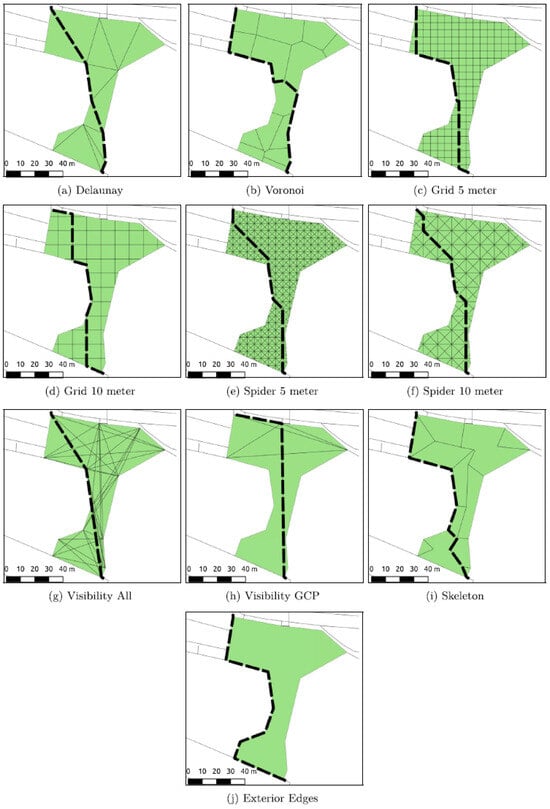
Figure 1
Open AccessArticle
Spatial Relationship of Inter-City Population Movement and Socio-Economic Determinants: A Case Study in China Using Multiscale Geographically Weighted Regression
by
Sihan Liu and Xinyi Niu
ISPRS Int. J. Geo-Inf. 2024, 13(4), 129; https://doi.org/10.3390/ijgi13040129 - 12 Apr 2024
Abstract
In the current field of regional studies, there is a growing focus on regional spatial relationships from the perspective of functional linkages between cities. Inter-city population movement serves as an embodiment of the integrated functionality of cities within a region, and this is
[...] Read more.
In the current field of regional studies, there is a growing focus on regional spatial relationships from the perspective of functional linkages between cities. Inter-city population movement serves as an embodiment of the integrated functionality of cities within a region, and this is closely tied to the socio-economic development of urban areas. This study utilized Location-Based Services (LBSs) to collect the scale of inter-city population movement across 355 cities in China. Additionally, socio-economic data published by local governments were incorporated. By establishing a Multiscale Geographically Weighted Regression (MGWR) model, this research explores the spatial relationships between inter-city population movement and socio-economic influencing factors in China. This study aims to elucidate the spatial scales of the relationships between various variables. Our research findings indicate that the relationship between inter-city population movement and potential socio-economic determinants exhibits spatial non-stationarity. It is better to explore this spatial relationship through the MGWR model as there are different determinants operating on inter-city population movement at different spatial scales. The spatial distribution of the coefficient estimates shows significant regional differences and numerical variations. In China’s economically developed coastal regions, there is relatively balanced development among cities, with advanced manufacturing and producer service industries acting as significant drivers of mobility. In inland regions of China, city size is the most influential variable, directing a substantial flow of human and economic resources towards regional socio-economic hubs such as provincial capitals. The main contribution of this study is the re-examination of the relationship between inter-city population movement and socio-economic factors from the perspective of spatial scales. This approach will help China to consider the heterogeneity of different regions more extensively when formulating regional development policies, thereby facilitating the targeted promotion of regional element flow.
Full article
(This article belongs to the Special Issue Application of Geographical Information System in Urban Design, Management or Evaluation)
►▼
Show Figures

Figure 1
Open AccessArticle
Search Engine for Open Geospatial Consortium Web Services Improving Discoverability through Natural Language Processing-Based Processing and Ranking
by
Elia Ferrari, Friedrich Striewski, Fiona Tiefenbacher, Pia Bereuter, David Oesch and Pasquale Di Donato
ISPRS Int. J. Geo-Inf. 2024, 13(4), 128; https://doi.org/10.3390/ijgi13040128 - 12 Apr 2024
Abstract
The improvement of search engines for geospatial data on the World Wide Web has been a subject of research, particularly concerning the challenges in discovering and utilizing geospatial web services. Despite the establishment of standards by the Open Geospatial Consortium (OGC), the implementation
[...] Read more.
The improvement of search engines for geospatial data on the World Wide Web has been a subject of research, particularly concerning the challenges in discovering and utilizing geospatial web services. Despite the establishment of standards by the Open Geospatial Consortium (OGC), the implementation of these services varies significantly among providers, leading to issues in dataset discoverability and usability. This paper presents a proof of concept for a search engine tailored to geospatial services in Switzerland. It addresses challenges such as scraping data from various OGC web service providers, enhancing metadata quality through Natural Language Processing, and optimizing search functionality and ranking methods. Semantic augmentation techniques are applied to enhance metadata completeness and quality, which are stored in a high-performance NoSQL database for efficient data retrieval. The results show improvements in dataset discoverability and search relevance, with NLP-extracted information contributing significantly to ranking accuracy. Overall, the GeoHarvester proof of concept demonstrates the feasibility of improving the discoverability and usability of geospatial web services through advanced search engine techniques.
Full article
(This article belongs to the Special Issue Unlocking the Power of Geospatial Data: Semantic Information Extraction, Ontology Engineering, and Deep Learning for Knowledge Discovery)
►▼
Show Figures
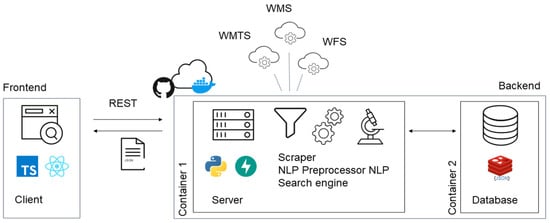
Figure 1
Open AccessArticle
Map Reading and Analysis with GPT-4V(ision)
by
Jinwen Xu and Ran Tao
ISPRS Int. J. Geo-Inf. 2024, 13(4), 127; https://doi.org/10.3390/ijgi13040127 - 11 Apr 2024
Abstract
In late 2023, the image-reading capability added to a Generative Pre-trained Transformer (GPT) framework provided the opportunity to potentially revolutionize the way we view and understand geographic maps, the core component of cartography, geography, and spatial data science. In this study, we explore
[...] Read more.
In late 2023, the image-reading capability added to a Generative Pre-trained Transformer (GPT) framework provided the opportunity to potentially revolutionize the way we view and understand geographic maps, the core component of cartography, geography, and spatial data science. In this study, we explore reading and analyzing maps with the latest version of GPT-4-vision-preview (GPT-4V), to fully evaluate its advantages and disadvantages in comparison with human eye-based visual inspections. We found that GPT-4V is able to properly retrieve information from various types of maps in different scales and spatiotemporal resolutions. GPT-4V can also perform basic map analysis, such as identifying visual changes before and after a natural disaster. It has the potential to replace human efforts by examining batches of maps, accurately extracting information from maps, and linking observed patterns with its pre-trained large dataset. However, it is encumbered by limitations such as diminished accuracy in visual content extraction and a lack of validation. This paper sets an example of effectively using GPT-4V for map reading and analytical tasks, which is a promising application for large multimodal models, large language models, and artificial intelligence.
Full article
(This article belongs to the Special Issue Advances in AI-Driven Geospatial Analysis and Data Generation)
►▼
Show Figures
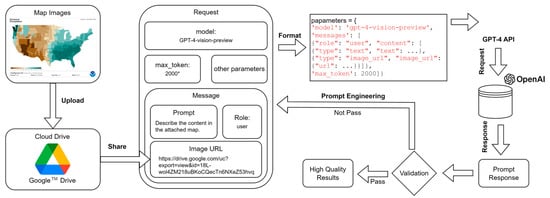
Figure 1
Open AccessArticle
Comparison of Different Green Space Measures and Their Impact on Dementia Cases in South Korea: A Spatial Panel Analysis
by
Wulan Salle Karurung, Kangjae Lee and Wonhee Lee
ISPRS Int. J. Geo-Inf. 2024, 13(4), 126; https://doi.org/10.3390/ijgi13040126 - 09 Apr 2024
Abstract
Dementia has become a profound public health problem due to the number of patients increasing every year. Previous studies have reported that environmental factors, including greenness, may influence the development and progression of dementia. Studies have found that exposure to green space is
[...] Read more.
Dementia has become a profound public health problem due to the number of patients increasing every year. Previous studies have reported that environmental factors, including greenness, may influence the development and progression of dementia. Studies have found that exposure to green space is associated with a lower incidence of dementia. However, many definitions of green space exist, and the effects of its use may differ with the type of green space. Therefore, two types of green space measures were considered in this study to assess the differences in their impact on the prevalence of dementia among females and males. This study used five years of data (2017–2021) from 235 districts in South Korea. The two green space measures used were open space density and normalized difference vegetation index (NDVI), which were derived from satellite images. The analysis utilized a combination of traditional and spatial panel analyses to account for the spatial and temporal effects of independent variables on dementia prevalence. The spatial autocorrelation results revealed that both measures of greenness were spatially correlated with dementia prevalence. The spatial panel regression results revealed a significant positive association between NDVI and dementia prevalence, and open space had a negative association with dementia prevalence in both genders. The difference in the findings can serve as the basis for further research when choosing a greenspace measure, as it affects the analysis results, depending on the objective of the study. This study adds to the knowledge regarding improving dementia studies and the application of spatial panel analysis in epidemiological studies.
Full article
(This article belongs to the Special Issue HealthScape: Intersections of Health, Environment, and GIS&T)
►▼
Show Figures

Figure 1
Open AccessArticle
Enhancing Adversarial Learning-Based Change Detection in Imbalanced Datasets Using Artificial Image Generation and Attention Mechanism
by
Amel Oubara, Falin Wu, Reza Maleki, Boyi Ma, Abdenour Amamra and Gongliu Yang
ISPRS Int. J. Geo-Inf. 2024, 13(4), 125; https://doi.org/10.3390/ijgi13040125 - 09 Apr 2024
Abstract
►▼
Show Figures
Deep Learning (DL) has become a popular method for Remote Sensing (RS) Change Detection (CD) due to its superior performance compared to traditional methods. However, generating extensive labeled datasets for DL models is time-consuming and labor-intensive. Additionally, the imbalance between changed and unchanged
[...] Read more.
Deep Learning (DL) has become a popular method for Remote Sensing (RS) Change Detection (CD) due to its superior performance compared to traditional methods. However, generating extensive labeled datasets for DL models is time-consuming and labor-intensive. Additionally, the imbalance between changed and unchanged areas in object CD datasets, such as buildings, poses a critical issue affecting DL model efficacy. To address this issue, this paper proposes a change detection enhancement method using artificial image generation and attention mechanism. Firstly, the content of the imbalanced CD dataset is enhanced using a data augmentation strategy that synthesizes effective building CD samples using artificial RS image generation and building label creation. The created building labels, which serve as new change maps, are fed into a generator model based on a conditional Generative Adversarial Network (c-GAN) to generate high-resolution RS images featuring building changes. The generated images with their corresponding change maps are then added to the CD dataset to create the balance between changed and unchanged samples. Secondly, a channel attention mechanism is added to the proposed Adversarial Change Detection Network (Adv-CDNet) to boost its performance when training on the imbalanced dataset. The study evaluates the Adv-CDNet using WHU-CD and LEVIR-CD datasets, with WHU-CD exhibiting a higher degree of sample imbalance compared to LEVIR-CD. Training the Adv-CDNet on the augmented dataset results in a significant 16.5% F1-Score improvement for the highly imbalanced WHU-CD. Moreover, comparative analysis showcases the superior performance of the Adv-CDNet when complemented with the attention module, achieving a 6.85% F1-Score enhancement.
Full article
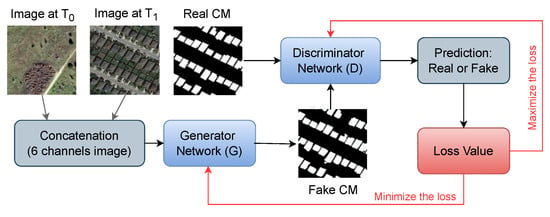
Figure 1
Open AccessArticle
Mapmaking Process Reading from Local Distortions in Historical Maps: A Geographically Weighted Bidimensional Regression Analysis of a Japanese Castle Map
by
Naoto Yabe
ISPRS Int. J. Geo-Inf. 2024, 13(4), 124; https://doi.org/10.3390/ijgi13040124 - 09 Apr 2024
Abstract
►▼
Show Figures
Shoho Castle Maps are maps of castle towns throughout Japan drawn by Kano School painters on the order of the shogun in 1644. The Shoho Castle Map of Takada, Joetsu City, Niigata Prefecture was used to visualize local distortions in historical maps and
[...] Read more.
Shoho Castle Maps are maps of castle towns throughout Japan drawn by Kano School painters on the order of the shogun in 1644. The Shoho Castle Map of Takada, Joetsu City, Niigata Prefecture was used to visualize local distortions in historical maps and to scrutinize the mapmaking process. A novel method, geographically weighted bidimensional regression, was developed and applied to visualize the local distortions of the map. Exaggerated expressions by mapmakers that have not been identified in previous studies were revealed. That is, in addition to the castle being drawn enlarged, the town where the merchants and artisans lived was drawn larger than the castle. Therefore, the Takada Shoho Castle Map reflects mapmakers’ intentions, besides enlarging military facilities, which appear to have emphasized the pictorial composition of the map by placing the main gate to the castle at the center and drawing the map area evenly from the center in a well-balanced layout.
Full article
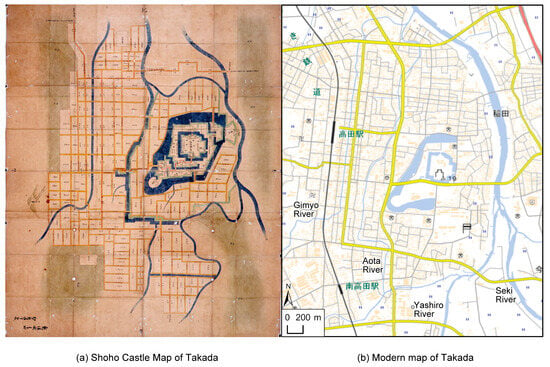
Figure 1
Open AccessArticle
Variability of Extreme Climate Events and Prediction of Land Cover Change and Future Climate Change Effects on the Streamflow in Southeast Queensland, Australia
by
Hadis Pakdel, Sreeni Chadalavada, Md Jahangir Alam, Dev Raj Paudyal and Majid Vazifedoust
ISPRS Int. J. Geo-Inf. 2024, 13(4), 123; https://doi.org/10.3390/ijgi13040123 - 08 Apr 2024
Abstract
►▼
Show Figures
The severity and frequency of extremes are changing; thus, it is becoming necessary to evaluate the impacts of land cover changes and urbanisation along with climate change. A framework of the Generalised Extreme Value (GEV) method, Google Earth Engine (GEE), and land cover
[...] Read more.
The severity and frequency of extremes are changing; thus, it is becoming necessary to evaluate the impacts of land cover changes and urbanisation along with climate change. A framework of the Generalised Extreme Value (GEV) method, Google Earth Engine (GEE), and land cover patterns’ classification including Random Forest (RF) and Support Vector Machine (SVM) can be useful for streamflow impact analysis. For this study, we developed a unique framework consisting of a hydrological model in line with the Process-informed Nonstationary Extreme Value Analysis (ProNEVA) GEV model and an ensemble of General Circulation Models (GCMs), mapping land cover patterns using classification methods within the GEE platform. We applied these methods in Southeast Queensland (SEQ) to analyse the maximum instantaneous floods in non-stationary catchment conditions, considering the physical system in terms of cause and effect. Independent variables (DEM, population, slope, roads, and distance from roads) and an integrated RF, SVM methodology were utilised as spatial maps to predict their influences on land cover changes for the near and far future. The results indicated that physical factors significantly influence the layout of landscapes. First, the values of projected evapotranspiration and rainfall were extracted from the multi-model ensemble to investigate the eight GCMs under two climate change scenarios (RCP4.5 and RCP8.5). The AWBM hydrological model was calibrated with daily streamflow and applied to generate historical runoff for 1990–2010. Runoff was projected under two scenarios for eight GCMs and by incorporating the percentage of each land cover into the hydrological model for two horizons (2020–2065 and 2066–2085). Following that, the ProNEVA model was used to calculate the frequency and magnitude of runoff extremes across the parameter space. The maximum peak flood differences under the RCP4.5 and RCP8.5 scenarios were 16.90% and 15.18%, respectively. The outcomes of this study suggested that neglecting the non-stationary assumption in flood frequency can lead to underestimating the amounts that can lead to more risks for the related hydraulic structures. This framework is adaptable to various geographical regions to estimate extreme conditions, offering valuable insights for infrastructure design, planning, risk assessment, and the sustainable management of future water resources in the context of long-term water management plans.
Full article

Figure 1

Journal Menu
► ▼ Journal Menu-
- IJGI Home
- Aims & Scope
- Editorial Board
- Reviewer Board
- Topical Advisory Panel
- Instructions for Authors
- Special Issues
- Topics
- Topical Collections
- Article Processing Charge
- Indexing & Archiving
- Editor’s Choice Articles
- Most Cited & Viewed
- Journal Statistics
- Journal History
- Journal Awards
- Society Collaborations
- Conferences
- Editorial Office
Journal Browser
► ▼ Journal BrowserHighly Accessed Articles
Latest Books
E-Mail Alert
News
Topics
Topic in
Drones, IJGI, Land, Remote Sensing
Advances in Earth Observation and Geosciences
Topic Editors: Diego González-Aguilera, Pablo Rodríguez-GonzálvezDeadline: 30 April 2024
Topic in
Healthcare, IJERPH, IJGI
Spatial Epidemiology and GeoInformatics
Topic Editors: Christos Chalkias, Demosthenes PanagiotakosDeadline: 30 June 2024
Topic in
Geomatics, IJGI
Geospatial Knowledge Graph
Topic Editors: Guohui Xiao, Yu Feng, Linfang Ding, Younes HamdaniDeadline: 1 August 2024
Topic in
Applied Sciences, Atmosphere, IJGI, Remote Sensing, Sustainability
Technological Innovation and Emerging Operational Applications in Digital Earth
Topic Editors: Zhihua Zhang, M. James C. CrabbeDeadline: 17 October 2024

Conferences
Special Issues
Special Issue in
IJGI
Application of Geographical Information System in Urban Design, Management or Evaluation
Guest Editors: Jiangfeng She, Jun Zhu, Min YangDeadline: 31 May 2024
Special Issue in
IJGI
Advances in AI-Driven Geospatial Analysis and Data Generation
Guest Editors: Hartwig H. Hochmair, Levente Juhász, Hao LiDeadline: 31 August 2024
Special Issue in
IJGI
Unlocking the Power of Geospatial Data: Semantic Information Extraction, Ontology Engineering, and Deep Learning for Knowledge Discovery
Guest Editors: Christos Chalkias, Marinos Kavouras, Margarita Kokla, Mara NikolaidouDeadline: 30 September 2024
Special Issue in
IJGI
Advances in Remote Sensing and GIS for Natural Hazards Monitoring and Management
Guest Editors: Adrianos Retalis, Dimitrios AlexakisDeadline: 31 December 2024
Topical Collections
Topical Collection in
IJGI
Spatial Components of COVID-19 Pandemic
Collection Editors: Fazlay S. Faruque, Peng Jia, Mo Ashifur Rahim
Topical Collection in
IJGI
Spatial and Temporal Modelling of Renewable Energy Systems
Collection Editors: Luis Ramirez Camargo, Johannes Schmidt, Wolfgang Dorner







